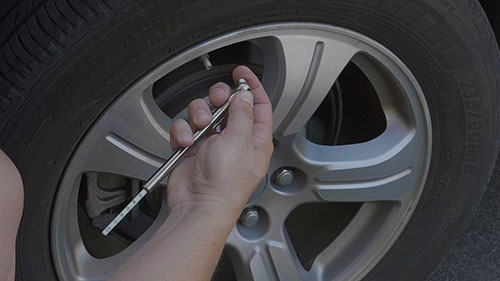Consumer Safety Overview
About Tires
Reading a Tire Sidewall
The tire sidewall contains important information that tells you everything about your tire regarding the dimensions, construction, operating characteristics and manufacturer.
Why Do Tires Fail
There are a lot of reasons why you see pieces of tire on the side of the road, but most of them are caused by heat. When a tire is traveling down the road, the sidewalls are flexing, which ultimately creates heat.
How Tires are Made
The most common type of passenger tires are radial tires, which consist of one or two casing, or sidewall, plies that are comprised of either fabric or steel cords and aligned 90 degrees to the beads.
Tire Maintenance
Tire Pressure Monitoring System
What is a Tire Pressure Monitoring System (TPMS)?
A Tire Pressure Monitoring System (TPMS) is an electronic system that monitors the air pressure inside a tire. The TPMS indicator light on the dashboard warns motorists that at least one of the tires on the vehicle needs attention because the air pressure is too low.
How do I know if my vehicle is equipped with TPMS?
Starting with the 2008 model year, all new passenger cars, SUVs and light trucks under 10,000 pounds must have a tire pressure monitoring system. So, if your car is 2008-model year or later, it has TPMS. Only certain models had TPMS prior to 2008, so 2007 model-year vehicles and older may or many not have a TPMS.
There are several ways to determine if you vehicle is equipped with TPMS. The simplest way is to check your owner’s manual and watch the dashboard indicator lights when the ignition is turned to the “on” position. There are two different low-tire pressure warning lights. The standard icon is a yellow cross-section of a tire that looks like a horseshoe with an exclamation point in the middle. The yellow letters “TPMS” also indicate that the vehicle is equipped with TPMS and the instrument panel may include images of the tires on a vehicle with the corresponding tire pressures for each tire.
Tire Service Life Recommendations
General Motors
(Chevrolet, GMC, Buick, Cadillac)

Consumer Safety Videos
Tire Safety Starts with Tire Registration
February 10, 2015
Tire Safety Starts with Tire Registration outlines the different methods that motorists can use to register their tires. It also explains the date code within the tire identification number (TIN).
Tire Safety Starts with Tire Selection
December 5, 2014
Tire Safety Starts with Tire Selection covers the basic guidelines that motorists should follow when selecting replacement tires. The video explains tire sizing and the importance of following the placard as well as the basic differences between all-season, summer, winter and all-terrain tires.
Tire Safety Starts with Inspection
June 4, 2014
Tire Safety Starts with Inspection covers the regular inspection procedures that motorists should follow to check their tires for sufficient tread depth and irregular wear. The video also includes animation that explains pinch shock, which causes a bulge to appear on the sidewall of the tire after striking a pothole, curb or road hazard.
Tire Safety Starts with Winter Tires
November 13, 2013
Tire Safety Starts with Winter Tires focuses on the safety advantages that winter tires provide when compared to standard all-season tires.
Tire Safety Starts with TPMS
October 24, 2013
Tire Safety Starts with TPMS gives a video overview of tire pressure monitoring systems (TPMS) that emphasizes the safety benefits associated with a system that warns the driver when one or more of their tires are underinflated.
Tire Safety Starts with Proper Tire Repair
October 24, 2013
Tire Safety Starts with Proper Tire Repair places a camera inside the tire so drivers can see what happens to the tread each time the tire makes a revolution. After multiple revolutions, the tire runs over a nail and viewers get a slow-motion replay of what it looks like inside a tire when a nail pokes through the innerliner.
